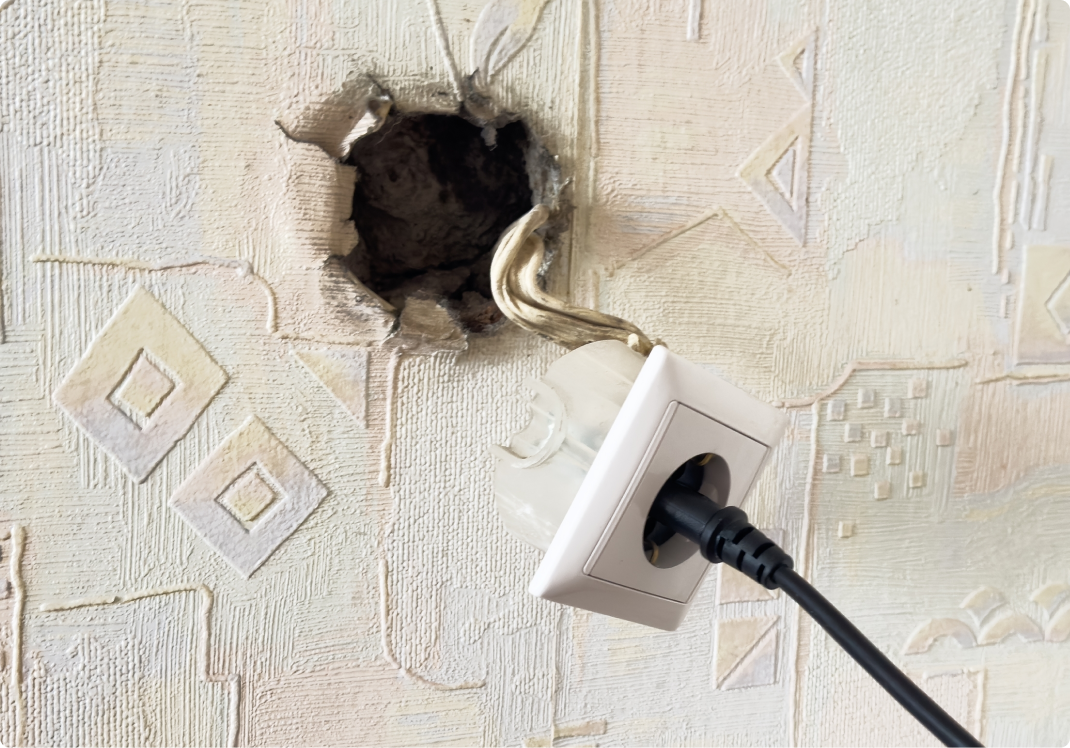1. Unfamiliar or funny odors
A new appliance might produce an unfamiliar odor upon first being installed. This could be due to the appliance's paint, finish or some other superficial issue. But should you detect an odd smell coming from an electrical outlet, unplug anything connected to it, and don’t use it again until a qualified electrician has checked it. Additionally, if your breaker panel or fuse box is emitting an odd odor, call an electrician immediately.
2. Arc faults
Arc faults occur when an electrical circuit veers off its intended path, often through a breach in the wiring. They are a frequent cause of electrical fires. However, arc faults are preventable through the installation of a device called an arc-fault circuit interrupter (AFCI). A professional electrician can install AFCIs. While they can be a bit pricey, the outlay is probably worth it, especially in older homes where the electrical wiring may have degraded.
3. Counterfeit electrical products
If you’ve ever gone to a flea market and seen vendors selling things like extension cords, power strips and night lights at ridiculously low prices, beware. There's a strong possibility that they are counterfeit or not up to either industry or government standards and incredibly dangerous. Purchase your electrical products from reputable, established dealers, and always check to make sure the product bears a seal from the Underwriters Laboratory (UL).
4. Warm or sparking outlets and switches
If your light switches are warm to the touch or an outlet is sparking, call a professional electrician immediately to see if your wiring needs repairs or the fixture should be replaced.
5. Buzzing sounds
Your outlets and switches should operate silently. If you hear any buzzing, cracking or sizzling sounds when you flip a switch or plug into an outlet, turn off the power to that fixture immediately and consult a professional electrician.
6. Flickering lights
Flickering lights usually indicate a power surge. These power surges don't necessarily have to come from a catastrophic event — more than likely, your appliances are making demands on the electrical system that it cannot handle. These surges can take a toll on both your appliances and your electrical fixtures. If flickering lights are a frequent occurrence, it may be time to consider upgrading the wiring in your home.
7. Broken light switches and loose outlets
If switches or outlets stop working or work only intermittently, it could be a sign of loose wiring — and another potential fire hazard. Loose outlets also create a potential for electrical shock. Even a partially exposed outlet could shock an unsuspecting individual who is plugging in or unplugging a cord.
8. Hot ceiling fixtures
Occasionally check the area around your ceiling fixtures for warmth that could indicate a lack of sufficient insulation. Also, exceeding recommended bulb wattages can cause overheating. Either issue poses a potential fire hazard. Consider switching to compact fluorescent light (CFL) or light-emitting diode (LED) bulbs as these don’t produce as much heat as incandescent bulbs.
9. Rodent droppings
Mice and rats love to chew on electrical wiring, and frayed or damaged wiring is a definite fire hazard. If you see any droppings or other signs of rodent activity in your attic, basement or around electrical fixtures, check all wiring in the area for signs of damage. If you're concerned about a rodent infestation, a pest control specialist can help you find out if you have an infestation and treat the problem.
10. Circuit breaker problems
Circuit breakers are designed to trip when a circuit is overloaded. Tripping prevents overheating and eliminates fire hazards. Occasional tripping probably indicates a simple overload, but if it occurs repeatedly, you need to call in an electrician and have them evaluate your entire electrical system.
Don’t Worry, Be Warranty
All American Home Shield plans include Electrical Systems & Accessories coverage, featuring protection for essential components of a home’s electrical system–perfect for making sure electrical issues in your house don’t become major headaches. This coverage extends to the repair or replacement of electrical wiring, service panels, and breakers, as well as related elements like outlets, switches, and doorbells. Additionally, our plans cover ceiling fans, exhaust fans, and garage door openers–ensuring that both critical and commonly used electrical features are safeguarded.
It’s just one way that American Home Shield helps homeowners manage the costs associated with owning a house, providing protection against unexpected issues.



